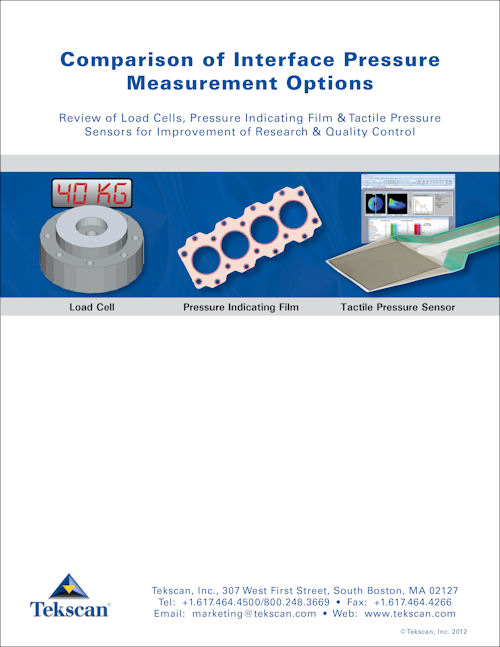Latest News
February 22, 2013
By Anthony J. Lockwood
Dear Desktop Engineering Reader: |
People often express their condolences when they hear that I once worked for Sensors magazine. But it was fascinating work. Sensing devices are perhaps the most important technology we all live with yet think absolutely nothing of until one in your car goes, the baby has a fever, or a machine suddenly shuts down “for no reason whatsoever.” Engineers doing test and measurement, quality control, calibration, process studies, medical research, and countless other tasks, however, know that the correct sensing device ensures that their analysis tools are right for the job requirements.
Aye, there’s the rub. Many types of sensors perceive and report the same sort of data, yet not all sensors are equal to your job at hand by any stretch of the imagination. This, in a nutshell, is the thesis underlying today’s Check It Out white paper from Tekscan.
“Comparison of Interface Pressure Measurement Options” is an exceptionally well-written paper. Its subtitle labels it a “review of load cells, pressure indicating film, and tactile pressure sensors for improvement of research and quality control.” Think of “review” in two generalized ways: Overview and analysis. These two topics consume two-thirds of this 18-page PDF. The final third is devoted to five quick application notes on the use of pressure sensors for such purposes as fuel cell stacks and battery plates, tire behavior during motion, and chemical-mechanical polishing.
There’s nothing general about the overview section. It serves as an in-depth, even-handed guide to the roles executed by load cells, pressure indicating film, and tactile pressure sensors. The pros and cons and even the basic construction of each device are explained individually. For example, when discussing loads cells, the unknown author lauds their durability, reliability, and accuracy while noting that too many load cells embedded into a structure can get expensive, destabilize structural integrity, and return skewed results.
Nor is there anything generalized about the analysis section. Here, the paper reports on an examination of the capabilities and limitations of each of the three pressure sensors. The test used an Instron machine to apply an identical load to each device. The analyses of what happened are individually reported and well illustrated. The upshot of it all is that each device can provide accurate and meaningful data. The trick is understanding each device, its competencies, and its constraints so that you know which device is right for your application.
My hat is off to Tekscan. It makes advanced thin-film tactile pressure and force sensors, systems, and enabling electronics. This paper could have come to praise themselves and bury load cells. It does not. Not by a long shot.
A “Comparison of Interface Pressure Measurement Options” provides a lot of information to help you make an informed decision when choosing a pressure-sensing device for your next application. Hit the link over there and download a copy for yourself. It’s well worth having around as a reference.
Thanks, Pal. – Lockwood
Anthony J. Lockwood
Editor at Large, Desktop Engineering
Subscribe to our FREE magazine, FREE email newsletters or both!
Latest News
About the Author
Anthony J. Lockwood is Digital Engineering’s founding editor. He is now retired. Contact him via [email protected].
Follow DE




